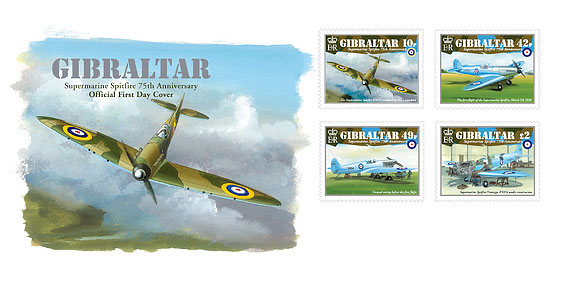Home -> Stamps -> 2011 -> Spitfire 75th Anniversary -> First Day Cover
We also recommend:

Spitfire 75th Anniversary (view technical specs)
The Supermarine Spitfire is a British single-seat fighter aircraft used by the Royal Air Force and many other Allied countries throughout the Second World War. The Spitfire continued to be used into the 1950s both as a front line fighter and in secondary roles. It was produced in greater numbers than any other British aircraft and was the only Allied fighter in production throughout the war.
The Spitfire was designed as a short-range high-performance interceptor aircraft by R. J. Mitchell, chief designer at Supermarine Aviation Works (since 1928 a subsidiary of Vickers-Armstrong). Mitchell continued to refine the design until his death from cancer in 1937, whereupon his colleague Joseph Smith became chief designer. The Spitfire’s elliptical wing had a thin cross-section, allowing a higher top speed than several contemporary fighters, including the Hawker Hurricane. Speed was seen as essential to carry out the mission of home defence against enemy bombers.
During the Battle of Britain there was a public perception that the Spitfire was the RAF fighter of the battle whereas in fact the more numerous Hurricane actually shouldered a greater proportion of the burden against the Luftwaffe: the Spitfire units did, however, have a lower attrition rate and a higher victory to loss ratio than those flying Hurricanes.
After the Battle of Britain, the Spitfire became the backbone of RAF Fighter Command and saw action in the European, Mediterranean, Pacific and the South-East Asian theatres. Much loved by its pilots, the Spitfire served in several roles, including interceptor, photo-reconnaissance, fighter-bomber, carrier-based fighter, and trainer. It was built in many different variants, using several wing configurations. Although the original airframe was designed to be powered by a Rolls-Royce Merlin engine producing 1,030hp (768 kW), it was adaptable enough to use increasingly more powerful Merlin and the later Rolls-Royce Griffon engines; the latter was eventually able to produce 2,035 hp (1,520 kW). (Text from Wikipedia)
Technical Specs
| Design: | Stephen Perera |
| Illustration / Photography: | John Batchelor |
| Printer: | BDT International |
| Process: | Offset Lithography |
| Colours: | 4 cols. |
| Stamp size: | |
| Issue date: | 2011-09-28 |
| Stamp Values: |













